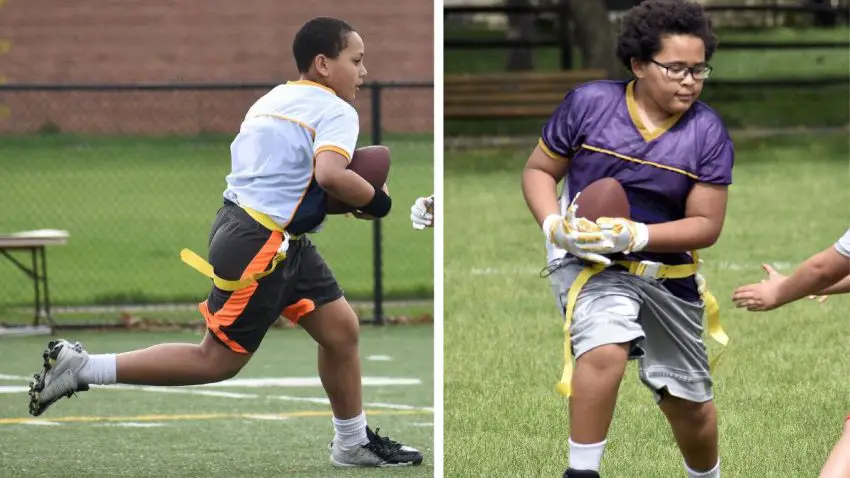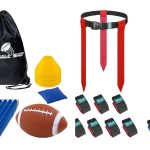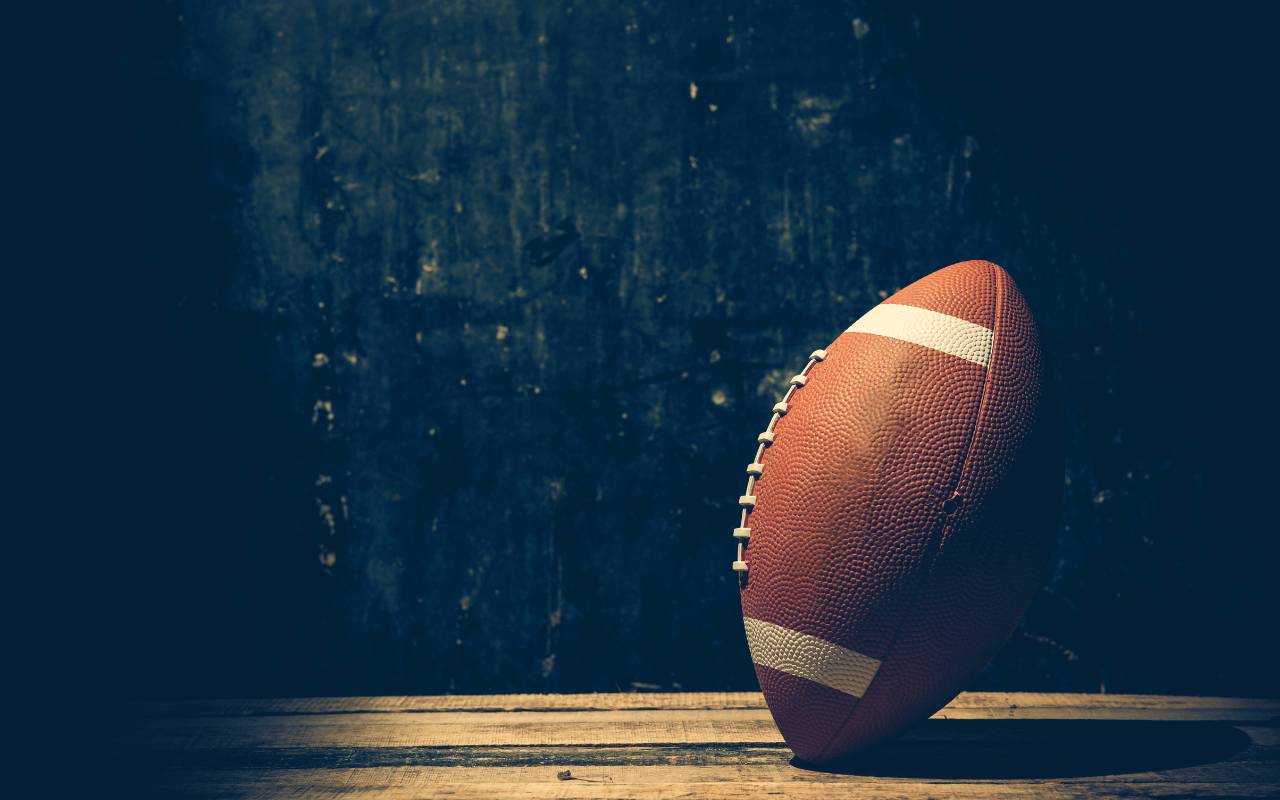Imagine you’re playing flag football, and you’ve got the perfect combination of speed, agility, and vision on your team. You might be a perfect running back.
Like a superhero racing to save the day, the running back plays a crucial role in flag football. Despite the absence of tackling and very few rushing plays, the running back’s skills still shine through, making them a valuable asset on the field.
In this blog post, we’ll dive deep into the world of the running back position, exploring the skills, strategies, and plays that will make any ball carrier a formidable force on the field.
Running Back Responsibilities and Roles in Flag Football
The role of the running back is multifaceted and crucial to the success of the team’s offense. The primary responsibility of the position (which is also known as a halfback or tailback) is to carry the ball and make forward progress toward the opponent’s end zone.
Their duties extend beyond just carrying the ball. Here are some key aspects of the running back’s role in flag football:
Ball carrier: As the primary ball carrier, the RB is responsible for making the most of each handoff or pitch they receive from the quarterback. This involves using their speed, agility, and vision to find open lanes, dodge linebackers and other defenders, and advance the ball downfield.
Receiver: Running backs often act as pass catchers in the offensive scheme. They may run routes out of the backfield or line up as a receiver out wide. This versatility adds another dimension to the team’s offense.
Misdirection option: Running backs play a vital role in executing misdirection plays, such as fake handoffs, reverses, and play-action passes. These plays are designed to deceive the defense and create opportunities for big gains.
Red zone threat: In the red zone (the area of the field close to the opponent’s end zone), running backs become even more critical. Their ability to find holes in the defense, catch short passes, and elude defenders can lead to touchdowns.
Essential Running Back Skills for Flag Football
Noting the responsibilities of the position above, here we share skills all good running backs need to have success in the sport of flag football.
Speed and agility: As a running back, think of yourself as a cheetah sprinting through the savannah, swiftly maneuvering past obstacles. Your speed and agility are essential for dodging defenders and making explosive plays. Most backs practice ladder drills and cone exercises to improve footwork and change of direction.
Vision and field awareness: As a running back, vision and field awareness are vital for spotting holes in the defense and identifying cutback lanes. To sharpen these skills, many players watch film, practice in game-like settings, and participate in vision exercises.
Ball handling: Picture the smooth handoff between a relay team in the Olympics. In flag football, proper ball handling and handoff techniques are crucial to avoid fumbles and ensure successful plays. This can be done through practice receiving handoffs from the quarterback and carrying the ball securely tucked under your arm.
Route running: A running back’s role is more than just carrying the ball. In flag football, they are also highly involved in catching passes and running after the catch. You can study route running techniques to become a versatile weapon.
If don’t think running back is your thing, check out other flag football positions to try.
Practice Drills for Running Backs
To develop and refine the skills needed to excel as a flag football running back, consider using the following drills in your practice routine:
Ladder Drills: This drill improves footwork, speed, and agility. Using an agility ladder, perform exercises like the Ickey Shuffle, Two-In Two-Out, and Lateral High Knees to enhance your foot speed and coordination.
Cone Drills: Cone drills help to develop cutting and change-of-direction abilities. Set up cones in various patterns (e.g., zig-zag, T-drill, or L-drill) and practice accelerating, decelerating, and changing direction as you navigate through the cones.
Handoff Drills: Practice taking handoffs from a quarterback or coach to work on your technique, ball security, and acceleration after getting the ball. Incorporate different types of handoffs, such as direct handoffs, pitches, and laterals.
Catching Drills: Work on catching passes from different angles, focusing on hand-eye coordination and securing the ball before turning upfield. Some popular catching drills include the Diamond Drill, Quick Hands Drill, and Tennis Ball Drill.
Ball Security Drills: Practice holding the ball high and tight, using the “five points of pressure” technique (fingertips, palm, forearm, bicep, and chest).
Vision Drills: Enhance your vision and field awareness by participating in vision drills like the Mirror Drill, where you follow a teammate’s movements while facing each other, or the Reaction Ball Drill, which involves reacting to a ball that bounces unpredictably.
Conditioning Drills: To build endurance and stamina, perform conditioning exercises like sprints, interval training, and hill runs. This will help you maintain peak performance throughout the game.
Top 5 Flag Football Plays for Running Backs
Play 1. The Sweep: Picture yourself as a powerful wave crashing onto the shore. On a sweep play, the RB receives a handoff from the quarterback and swiftly runs around the edge of the formation down the sideline.
Play 2. The Draw: Envision a master illusionist, fooling the audience with a clever trick. The draw play is designed to deceive the defense into thinking it’s a pass play, allowing the RB to exploit open running lanes.
Play 3. The Counter: The counter play starts with a fake in one direction, only for the back to cut back against the flow, taking advantage of the defense’s over-pursuit.
Play 4. The Wheel Route: In this passing play, the RB starts by running a short route, then breaks upfield in a curved path, creating separation from defenders and providing a deep target for the QB.
Play 5. The Dump Off: The dump pass is designed to let the defense penetrate the backfield, only for the RB to slip out to the flat and turn a short throw into a big gain.
Take a look at our Best 7-on-7 plays!
Final Thoughts
The running back in flag football is like a secret weapon, capable of turning the tide of any game with their speed, agility, and vision. By mastering the skills, strategies, and plays discussed in this post, you’ll become an unstoppable force on the field.
Now it’s time to lace up your cleats, hit the gridiron, and show the world what you’ve got!

Vance J has played flag football since he was a boy. Since then, he has become a coach and a huge advocate for growing the sport. He loves to write and talk about flag football!







